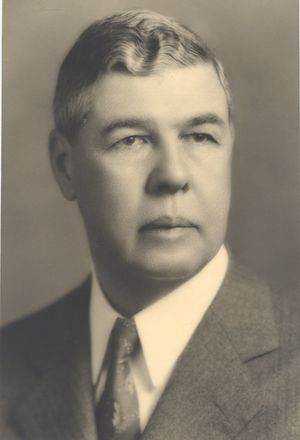Alan Hazeltine: Difference between revisions
No edit summary |
No edit summary |
||
| Line 1: | Line 1: | ||
== Louis Alan Hazeltine: Biography == | == Louis Alan Hazeltine: Biography == | ||
[[Image:2029 - hazeltine.jpg|thumb|left]] | |||
<p>Born: 1886 </p> | |||
<p>Died: 1964 </p> | |||
<p>Louis Alan Hazeltine was born in 1886 in Morristown, New Jersey, and graduated in mechanical engineering from the Stevens Institute of Technology in 1906. He then spent a little over a year in the testing department of the [[General Electric (GE)|General Electric Company]] in Schenectady, New York, He returned to Stevens to teach electrical engineering beginning in 1907 and became department head in 1917, He was stimulated by early papers of [[Edwin H. Armstrong|Edwin H. Armstrong]] to begin research on [[Electron (or Vacuum) Tubes|vacuum-tube]] circuits and became active in both the [[IRE History 1912-1963|IRE]] and the Radio Club of America. He was elected a [[IEEE Fellow Grade History|Fellow]] of the [[IRE History 1912-1963|IRE]] in 1921 and later served as [[Presidents of the Institute of Radio Engineers (IRE)|President of the IRE]] in 1936. Hazeltine authored a textbook entitled Electrical Engineering, which was published in 1924. He achieved a reputation as an inspiring teacher and his teaching was said to have been "orderly and methodical." . </p> | |||
Hazeltine | <p>In 1918, Hazeltine became a radio consultant to the U.S. Navy and designed a receiver for use on destroyers. The receiver, known as the SE 1420, was highly regarded and enjoyed long usage. In 1922, he designed a receiver suitable for broadcast reception that employed neutralization of internal capacitive coupling in high-gain amplifiers. Commercial versions of this receiver, known as the neutrodyne, were introduced in 1923, and, the following year, the Hazeltine Corporation was founded to manage his neutrodyne patents and provide engineering services to clients. Neutrodyne receivers were made by more than 20 firms during the 1920s and Hazeltine received approximately $3,000,000 in royalties from licensees by 1927. The advent of screen-grid tubes beginning in 1926 quickly rendered the neutrodyne obsolete. </p> | ||
[[Category:People_and_organizations]] [[Category:Engineers]] | <p>Hazeltine ended temporarily his tenure at Stevens in 1925. He lived in Europe for two years in the early 1930s and studied mathematics and art history in France before returning to the United States. In 1933 he resumed his teaching career at Stevens as Professor of mathematical physics and continued teaching until 1944. During World War II, he served as a consultant to the Office of Scientific Research and Development. After the War, he contributed to the development of television and did consulting work for the Hazeltine Corp.. He received 36 patents during his career. He was a mentor and colleague of [[Oral-History:Harold Wheeler|Harold Wheeler]], who wrote a biography entitled Hazeltine the Professor published in 1978. Hazeltine died in 1964 at the age of 78. </p> | ||
<p>[[Category:People_and_organizations]] [[Category:Engineers]]</p> | |||
Revision as of 19:57, 8 April 2010
Louis Alan Hazeltine: Biography
Born: 1886
Died: 1964
Louis Alan Hazeltine was born in 1886 in Morristown, New Jersey, and graduated in mechanical engineering from the Stevens Institute of Technology in 1906. He then spent a little over a year in the testing department of the General Electric Company in Schenectady, New York, He returned to Stevens to teach electrical engineering beginning in 1907 and became department head in 1917, He was stimulated by early papers of Edwin H. Armstrong to begin research on vacuum-tube circuits and became active in both the IRE and the Radio Club of America. He was elected a Fellow of the IRE in 1921 and later served as President of the IRE in 1936. Hazeltine authored a textbook entitled Electrical Engineering, which was published in 1924. He achieved a reputation as an inspiring teacher and his teaching was said to have been "orderly and methodical." .
In 1918, Hazeltine became a radio consultant to the U.S. Navy and designed a receiver for use on destroyers. The receiver, known as the SE 1420, was highly regarded and enjoyed long usage. In 1922, he designed a receiver suitable for broadcast reception that employed neutralization of internal capacitive coupling in high-gain amplifiers. Commercial versions of this receiver, known as the neutrodyne, were introduced in 1923, and, the following year, the Hazeltine Corporation was founded to manage his neutrodyne patents and provide engineering services to clients. Neutrodyne receivers were made by more than 20 firms during the 1920s and Hazeltine received approximately $3,000,000 in royalties from licensees by 1927. The advent of screen-grid tubes beginning in 1926 quickly rendered the neutrodyne obsolete.
Hazeltine ended temporarily his tenure at Stevens in 1925. He lived in Europe for two years in the early 1930s and studied mathematics and art history in France before returning to the United States. In 1933 he resumed his teaching career at Stevens as Professor of mathematical physics and continued teaching until 1944. During World War II, he served as a consultant to the Office of Scientific Research and Development. After the War, he contributed to the development of television and did consulting work for the Hazeltine Corp.. He received 36 patents during his career. He was a mentor and colleague of Harold Wheeler, who wrote a biography entitled Hazeltine the Professor published in 1978. Hazeltine died in 1964 at the age of 78.
